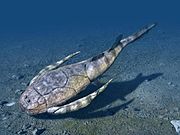| Aramus paludigrus | |
|---|---|
| Scientific classification | |
| Domain: | Eukaryota |
| Kingdom: | Animalia |
| Phylum: | Chordata |
| Clade: | Dinosauria |
| Class: | Aves |
| Order: | Gruiformes |
| Family: | Aramidae |
| Genus: | Aramus |
| Species: | †A. paludigrus
|
| Binomial name | |
| †Aramus paludigrus Rasmussen 1997
| |
Aramus paludigrus is an extinct species of limpkin, semi-aquatic birds related to cranes (order Gruiformes), which are similar. Aramus paludigrus was found in the famous Konzentrat-Lagerstätte of the Honda Group at La Venta, dating from the mid-Miocene period, in central Colombia.[1]
Description
This bird was described in 1997 based on a nearly complete tibiotarsus bone, very similar to its modern relative, the limpkin Aramus garaudana, although this element measured about 196 millimeters (7.7 in) long, which implies a 20% larger size. It also differs from the modern species in which this bone has larger lateral condyles, the axis of the bone is longer and narrower, very similar to that found in modern trumpeters (Psophia).[1] The general structure of this animal should not very different from the modern limpkins, being a rather sedentary bird (no remains are known from other parts of South America), and what is known of the strata in which he found, had to wade through swamps in search of snails, insects and bivalves to feed on them, that led to their scientific name, as in Greek paludigrus can be translated as "marsh crane."[1]



